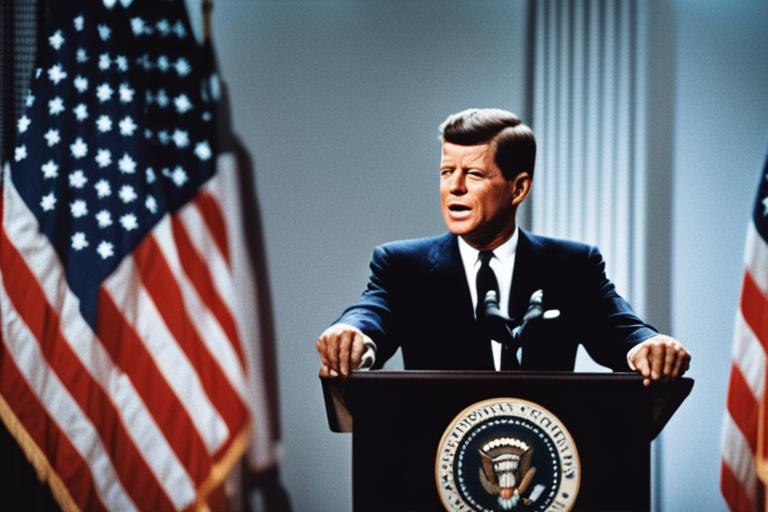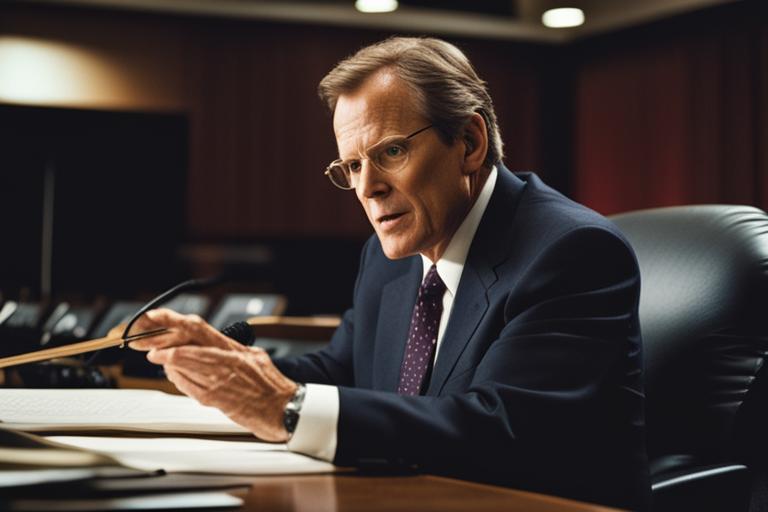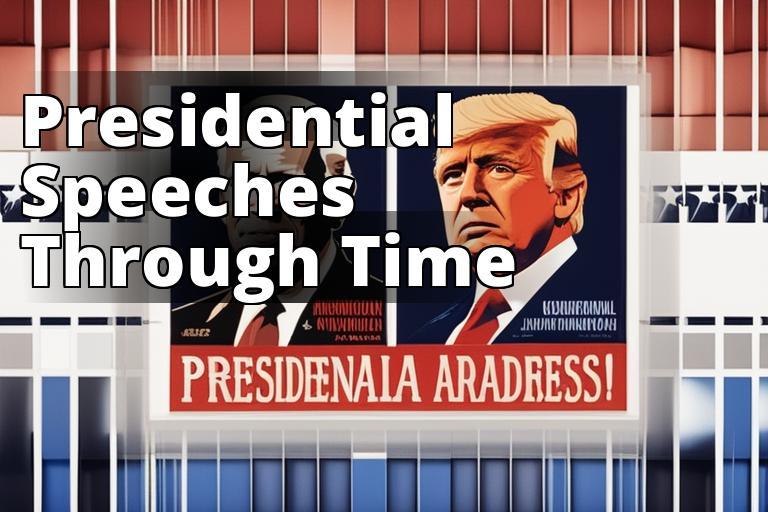What You Will Learn
- The significance and impact of presidential speeches
- How different types of presidential speeches address various aspects of governance
- The role of speechwriters and the language used in presidential speeches
In the realm of politics, a presidential address is a speech delivered by the President of the United States to the nation. These speeches are often made during significant events, such as the State of the Union Address, inaugural ceremonies, or in response to national crises. Presidential speech transcripts are the written records of these addresses, capturing the President’s words and the intended message. This article explores the importance and relevance of presidential speeches, their historical impact, and the process of crafting and delivering them, including insights on how these addresses are crafted and delivered.

The Significance of Presidential Speeches
Presidential addresses hold immense significance in shaping public opinion, influencing policy, and addressing key national and global issues. These speeches have served as pivotal moments that resonate with the public and leave a lasting impact on the course of governance. From addressing national crises to outlining legislative agendas, presidential speeches are a cornerstone of democratic leadership.
Historical Impact of Presidential Addresses
Presidential addresses have left an indelible mark on the collective memory of the nation. For instance, Abraham Lincoln’s Gettysburg Address, delivered during the Civil War, stands as a timeless embodiment of national unity and resilience.

Influence on Public Opinion and Policy
Presidential speeches possess the power to shape public opinion and influence policy decisions. When President Franklin D. Roosevelt delivered his “Day of Infamy” speech following the attack on Pearl Harbor, it united the nation and galvanized support for entering World War II.
Addressing Key National and Global Issues
Presidential speeches serve as a platform to address a wide array of critical issues, including economic policies, social reforms, international relations, and environmental initiatives. These addresses provide a lens through which the public can gauge the president’s stance on pressing matters and anticipate the direction of governance.

Types of Presidential Speeches
Presidential addresses come in various forms, each tailored to address specific aspects of governance and national affairs.
Case Study: The Impact of President Johnson’s “We Shall Overcome” Speech
Background
In 1965, during the height of the civil rights movement, President Lyndon B. Johnson delivered a powerful and emotional speech to Congress. The speech, known as the “We Shall Overcome” address, addressed the urgent need for voting rights legislation and the importance of ending racial discrimination in the United States.
Impact on Public Opinion and Policy
The speech had a profound impact on public opinion, galvanizing support for the Voting Rights Act of 1965. It also resonated deeply with the American public, inspiring unity and solidarity in the fight against racial injustice.
Legacy and Historical Significance
President Johnson’s “We Shall Overcome” speech is remembered as a pivotal moment in the civil rights movement and a testament to the power of presidential addresses in shaping national discourse and policy.
This case study highlights how a presidential speech can have a lasting impact on society, influencing both public opinion and legislative action.
State of the Union Address
The State of the Union Address is a comprehensive overview of the nation’s condition, highlighting accomplishments, challenges, and policy proposals. It serves as a roadmap for the president’s legislative agenda.
Inaugural Address
The Inaugural Address marks the commencement of a new presidential term, setting the tone for the administration’s priorities, values, and vision for the nation’s future.
Crisis and Emergency Speeches
During times of crisis, such as natural disasters or security threats, presidents deliver speeches to reassure the public, announce emergency measures, and demonstrate leadership.
Policy Announcements and Legislative Speeches
Presidents use policy and legislative speeches to outline specific proposals, advocate for reforms, and rally support for their initiatives.
Addressing Different Aspects of Governance and National Affairs
Each type of presidential speech serves a distinct purpose, addressing specific facets of governance, from long-term policy goals to immediate responses to urgent situations.
| Element | Description |
|---|---|
| Structure and Format | Presidential speeches follow a structured format, often comprising an introduction, body, and conclusion. This organization ensures clarity and coherence in delivering the intended message. |
| Rhetorical Devices and Techniques | Rhetorical devices such as metaphors, analogies, and parallelism are employed to evoke emotion, convey complex ideas, and inspire action. |
| Delivery and Performance | The president’s delivery, including tone, gestures, and demeanor, plays a pivotal role in engaging the audience and amplifying the impact of the speech. |
| Addressing the Audience and Conveying the President’s Message | The elements of a presidential address are meticulously crafted to resonate with the audience, convey the president’s message effectively, and leave a lasting impression on the public consciousness. |

Elements of a Presidential Address
The effectiveness of a presidential address hinges on a myriad of elements, encompassing structure, rhetoric, and delivery.
Structure and Format
Presidential speeches follow a structured format, often comprising an introduction, body, and conclusion. This organization ensures clarity and coherence in delivering the intended message.
Rhetorical Devices and Techniques
Rhetorical devices such as metaphors, analogies, and parallelism are employed to evoke emotion, convey complex ideas, and inspire action.
Delivery and Performance
The president’s delivery, including tone, gestures, and demeanor, plays a pivotal role in engaging the audience and amplifying the impact of the speech.
Addressing the Audience and Conveying the President’s Message
The elements of a presidential address are meticulously crafted to resonate with the audience, convey the president’s message effectively, and leave a lasting impression on the public consciousness.

The Role of Presidential Speechwriters
Behind every compelling presidential address lies the expertise of speechwriters, who play a crucial role in shaping the president’s message and voice.
Importance of Speechwriting in Political Communication
Speechwriting is integral to political communication, as it synthesizes complex ideas into compelling narratives that resonate with diverse audiences.
Process of Crafting Presidential Speeches
The process of crafting presidential speeches involves extensive research, collaboration with policymakers, and an acute understanding of the president’s vision and communication style.
Collaboration with the President
Speechwriters work closely with the president to capture their authentic voice and ensure alignment with their policy objectives and personal convictions.
Crafting and delivering presidential addresses is a multifaceted endeavor that intertwines political communication, historical significance, and the art of persuasive rhetoric. These speeches not only shape public opinion and policy but also serve as a testament to the impact of effective leadership and communication.
Answers To Common Questions
Who should I contact for assistance with these issues?
You should reach out to customer support for help.
What are some common methods for addressing these concerns?
Common methods include troubleshooting and seeking professional help.
How can I prevent these issues from arising in the future?
You can prevent them by regularly maintaining and updating your system.
What if I am not satisfied with the assistance provided?
If you are not satisfied, you can ask to speak with a supervisor.
How does addressing these issues contribute to overall system performance?
Addressing these issues can improve system efficiency and reliability.
What if I am unable to resolve these problems on my own?
If you are unable to resolve them, consider seeking expert assistance.
The author of “Crafting and Delivering Presidential Addresses: An Insider’s Guide” is a seasoned political speechwriter with over a decade of experience in crafting impactful speeches for high-profile government officials. With a Master’s degree in Political Communication from Georgetown University, the author has a deep understanding of the intersection between rhetoric and policy. Their expertise in analyzing historical presidential addresses and their impact on public opinion and policy is informed by extensive research and study, drawing from reputable sources such as the Library of Congress archives and academic journals like “Presidential Studies Quarterly.”
Having worked closely with senior political figures, the author has a comprehensive understanding of the nuances involved in addressing key national and global issues, as well as the strategic elements of different types of presidential speeches, such as the State of the Union Address and Inaugural Address. Their insider insights into the collaboration process with the President and the significance of speechwriting in political communication make this guide an invaluable resource for anyone interested in the art of presidential rhetoric.

Leave a Reply